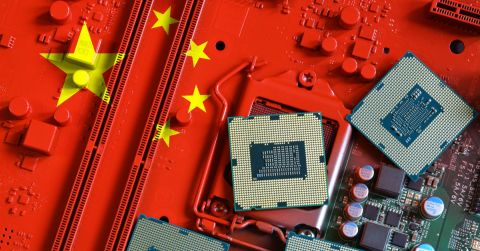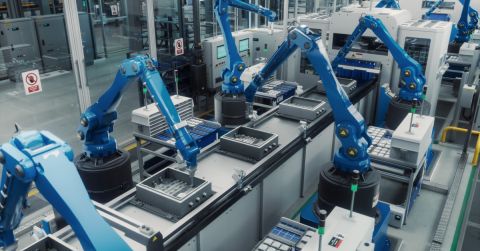Can RISC-V Help Companies Overcome Supply Chain Challenges?

It has been more than five years since the COVID-induced supply chain woes began, and companies are still dealing with the fallout of massive demand for semiconductors. Despite supply chain challenges, companies still need to be competitive and release new products on aggressive timelines. To help speed up time to market, semiconductor vendors and startups have turned to an open ISA (Instruction Set Architecture) standard to create their new products.
The number of products being built on RISC-V has grown dramatically since 2022, with projections showing the RISC-V market is expected to reach $1.41 billion in 2025 and grow at a compound annual growth rate (CAGR) of 37.85% to reach $7.00 billion by 2030, according to Mordor Intelligence research. What was once considered an academic curiosity has now become a mainstream alternative embraced by major technology players and startups alike.
Major tech companies outside of traditional semiconductor manufacturers have intensified their RISC-V adoption, including Intel Foundry Services (IFS), which has expanded its RISC-V portfolio since first announcing its intention to make RISC-V-based designs available through its Foundry Innovation System program. In 2022, Intel established a $1 billion fund to support RISC-V ecosystem development and promised "substantial contributions" to the RISC-V architecture and software stack. The organic ecosystem springing up around RISC-V continues to provide viable alternatives to supply chain challenges preventing the procurement of legacy products.
What Makes RISC-V So Popular?
RISC-V is an open processor development framework with a complete, ready-to-use instruction set. This ISA is totally open-source, and custom instructions can be added or removed as needed to implement specialty logic at the hardware level. The advantages of such a specification are numerous, including:
- IC developers can access a complete ISA framework and open-source chip designs without paying a license for a proprietary ISA
- Startups have begun innovating their own IP portfolios on top of RISC-V and building their own ecosystems to compete with Arm
- Core designs can be translated to VHDL or using vendor IP for instantiation in an FPGA
- Non-profit development groups, foundations, universities, and individual developers can implement their own chip designs and build on multi-project wafers
One of RISC-V's most powerful advantages is its cost-reduction potential, with reports indicating it can drive down chip development costs by as much as 50% for companies that strategically leverage it. This is largely due to its open-source nature, which eliminates licensing fees and allows for greater customization. For example, a report from Research and Markets highlights that "the combination of RISC-V and chiplet technology reduces the cost and threshold of chip design," making it an attractive option for companies looking to innovate while cutting expenses. These drastic cuts in expenses are fundamentally shifting the economics of chip design, enabling smaller players to compete in markets traditionally dominated by proprietary architectures like Arm and x86.
Currently, RISC-V has made significant progress but still isn't fully competitive with Arm and x86 at the highest end of computing products. However, it has found its market niche in smaller 32-bit cores and accelerators, particularly in fragmented sectors like IoT and industrial applications where customization and cost-efficiency are key. According to Tom's Hardware, "RISC-V is often used for microcontrollers and lower-performance CPUs, but its open-source nature and lack of licensing fees make it ideal for IoT and industrial applications". This flexibility has allowed RISC-V to thrive in areas where proprietary architectures struggle to meet the demand for tailored solutions.
It is also finding increased adoption in mid-range processors and specialty ASICs for advanced applications like AI. For instance, Alibaba's DAMO Academy recently launched the XuanTie C930, a server-grade RISC-V CPU designed for AI and high-performance computing, which rivals traditional architectures in specific workloads. As reported by Asia Times, "The C930, with 256-bit vector registers, supports advanced workloads like FP16 and INT8, ideal for datacenters and autonomous vehicles".
The highest-end RISC-V processors now in development, such as the XiangShan processor from the Chinese Academy of Sciences, are showing promise to challenge established architectures in specific domains. The XiangShan project, described as "the world’s top-performing open-source processor core," demonstrates the potential of RISC-V to compete in high-performance computing.
How Can RISC-V Help Solve Supply Chain Challenges?
It might not be obvious how an open standard like RISC-V helps solve supply chain challenges revolving around new product releases. After all, companies don't generally look to the open-source community when they have an issue with software vendors, they typically just switch vendors. While companies have managed through supply constraints as best they can over the last several years, hardware can be unique as it has limited perfect replacements, and developing your own replacement has traditionally had a significant barrier to entry.
- Shifting to RISC-V enables a new approach to procurement, where companies may no longer need to rely on vendors who are building on their proprietary ISAs.
- When a desired Arm-based or x86-based chip is unavailable, you could use lower-cost IP or design your own core from the RISC-V standard.
- Another option is to just use an FPGA with vendor IP, and you can instantiate any of your system's Arm-based ASICs into a single RISC-V component.
The RISC-V ecosystem has matured significantly since 2022, with companies like SiFive leading the charge. In August 2024, SiFive launched its Performance P870-D datacenter processor designed for highly parallelizable infrastructure workloads including video streaming, storage, web appliances, and AI applications. This development signals RISC-V's growing presence in higher-performance computing segments previously dominated by x86 and Arm.
You Still Need Fab Capacity
Assuming you aren't going to go the FPGA route, it should be noted that RISC-V doesn't help you overcome a lack of chip manufacturing capacity. Given the amount of time required to bring a new fab online (multiple years), RISC-V isn't going to eliminate any manufacturing capacity challenges. Some would argue that shifting to RISC-V takes up more capacity; there is currently an undersupply of existing chips, and adding new orders for RISC-V-based chips into the backlog simply extends the lead times for everything else.
This challenge has been further complicated by recent geopolitical developments. In early 2025, the United States increased import tariffs on Chinese semiconductors from 25% to 50%, which White House officials justified as necessary to protect investments made through the CHIPS Act. However, tensions have escalated further since then. On April 3, 2025, the U.S. announced a 34% "reciprocal tariff" on Chinese goods, prompting China to retaliate with a 34% blanket tariff on all U.S. imports, effective April 10. Additionally, China has introduced export restrictions on rare earth elements and sanctioned 30 U.S. defense-related organizations, signaling a significant escalation in the trade conflict.
Simultaneously, China has accelerated its own RISC-V development as a strategy to reduce dependence on Western technology. Reports indicate that the Chinese government is moving forward with plans to issue guidance encouraging nationwide use of RISC-V chips, with some policies already in effect as of April 2025. This aligns with China's broader strategy to counter U.S. trade restrictions and bolster its domestic semiconductor ecosystem.
Meanwhile, the U.S. has threatened additional tariffs on Chinese goods, with some reports suggesting rates could climb as high as 50% or more if China does not reverse its retaliatory measures. These developments have further strained global supply chains, with chipmakers like TSMC warning of potential disruptions and financial impacts.
The takeaway is: assuming you can secure time and space in a fab, systems developers will no longer be tied to buying products that use proprietary ISAs. They can use an open-source core and build on their own. For larger technology players that need their own chips, RISC-V continues to look like a great path forward for traditional processor architectures, especially as global tensions create uncertainties in semiconductor supply chains.
RISC-V Products Leading 2025
We've already outlined some of the newest RISC-V IP and supporting products from major semiconductor manufacturers, and the industry continues to accelerate development. As of early 2025, here are some of the most notable recent RISC-V implementations:
- SiFive Performance P870-D Datacenter Processor: Released in August 2024, this high-performance processor is designed for infrastructure workloads, including AI applications, and offers scalability up to 256 cores. The P870-D is fully compliant with the RVA23 RISC-V Instruction Profile, which ensures software portability across implementations. It also supports advanced features like the RISC-V Sv57 virtual address space extension and AMBA CHI protocol for efficient cross-cluster communication.
- China's XiangShan Project: This ambitious RISC-V development effort from the Chinese Academy of Sciences is expected to deliver a high-performance processor in 2025 that could compete in datacenter applications. The project uses the Mulan PSL-2.0 license, which grants a perpetual, royalty-free license to reproduce and distribute the IP. The XiangShan processor is being positioned as a key player in China's strategy to reduce reliance on Western technology.
- SpacemiT Key Stone K1: This octa-core 64-bit processor, developed in 2024, is now available in multiple computing platforms, including the LicheePi 3A and Milk-V Jupiter. SpacemiT has also announced the development of a server processor with up to 64 RISC-V cores for release in 2025. Early benchmarks suggest it could rival older x86 architectures in specific workloads.
- Renesas RISC-V ASSP Motor Control Systems: These systems have been upgraded with built-in AI extensions to improve industrial automation workflows, enabling predictive maintenance in manufacturing environments. Renesas continues to expand its RISC-V portfolio to address the growing demand for smart industrial solutions.
- PolarFire SoC by Microchip: This system-on-chip has been enhanced to support advanced machine vision applications, offering ultra-low power consumption for surveillance and edge analytics. It remains a popular choice for edge computing applications where power efficiency is critical.
One of the key developments accelerating RISC-V adoption is the ratification of the RVA23 Profile by RISC-V International. This profile defines mandatory extensions for specific device classes, addressing one of RISC-V's historical challenges: fragmentation. By ensuring software portability across different RISC-V implementations, the RVA23 Profile is helping to standardize the ecosystem and reduce development costs.
AI and RISC-V: Driving New Adoption
AI capabilities are now embedded in nearly every modern industry, and RISC-V has become increasingly important for systems handling AI-specific workloads. The automotive world is particularly excited about RISC-V not just for its customizability, but also for its ability to handle AI workloads, with an expected 66% annual growth in automotive applications. According to Omdia, "RISC-V has unique, desirable aspects for the automotive industry," including the ability to own and customize designs, which is critical for AI-driven applications like autonomous vehicles and advanced driver assistance systems (ADAS).
As Edward Wilford, Senior Principal Analyst for IoT at Omdia, explains, "RISC-V makes the most sense in novel applications, where a developer doesn't already have an existing Arm product in place. The rise of AI, the increase in use cases and capabilities, means a lot of new territory is being revealed, and all of it has potential for RISC-V".
Examples of products integrating AI with RISC-V include:
- Kneron AI Accelerator Chips: Kneron’s KL530 processor targets automotive applications, delivering 0.5 trillion INT8 operations per second (TOPS) and supporting INT4 formats for greater throughput. It is designed to enhance ADAS and enable Level 1 and Level 2 autonomy in vehicles.
- Esperanto Technologies' 1,000-core RISC-V AI Chip: Esperanto’s ET-SoC-1 chip, featuring over 1,000 RISC-V cores, is being tested with Samsung IT services for AI workloads. The chip is designed for energy-efficient AI inference and generative AI applications, offering a scalable and low-power solution for enterprise edge and datacenter deployments.
- SiFive's Intelligence Products: SiFive leverages RISC-V vector extensions in its Intelligence product line to optimize AI workloads. These processors are designed for applications requiring high parallelism, such as machine learning and data analytics, and are fully compliant with RISC-V standards.
RISC-V’s flexibility and open architecture continue to make it a compelling choice for industries looking to innovate in AI and automotive applications. With its ability to support custom silicon designs and emerging standards, RISC-V is well-positioned to drive the next wave of AI advancements.
A Solution for Supply Chain Flexibility
The modular nature of RISC-V has made it particularly valuable for companies navigating ongoing supply chain uncertainties. Between 2022 and 2025, its open-source adaptability has allowed manufacturers to maintain production pipelines despite global silicon shortages.
According to industry analysts, RISC-V is projected to see significant growth, with cumulative shipments of RISC-V cores potentially reaching 62.4 billion by 2025, as reported by Semico Research. However, the number of active cores in use is likely to be much lower, with some estimates suggesting 20 billion SoCs by 2031, according to The Register.
This growth signals a fundamental shift in how companies approach processor development, licensing, and innovation. For decades, the market has been controlled by proprietary architectures, forcing companies to either license expensive cores or design their technology around restrictive ecosystems. RISC-V is changing that equation by offering a royalty-free, highly customizable alternative.
When starting your next project, leverage Octopart's search and filtration features to find the latest components required for advanced RISC-V designs.









